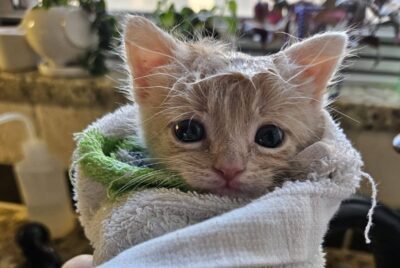
[ad_1]

Regular readers of my blog will know that my family and I have raised numerous foster kittens over the years. We have had queens and kittens, kittens without moms and infant kittens with their umbilical cords still attached. Raising kittens by hand is a lot of work but rewarding and heartwarming to see them learn to “spiderman” up the side of the sofa and crawl into your lap.
Despite fostering over 100 kittens, Saturday night was a new experience for me. Acorn and Cashew, two little boy orange kittens about four weeks old, had been doing brilliantly. They were eating, starting to use the litterbox and developing individual personalities. However, when the 8pm feeding rolled around, Cashew had a bit of white glop on his face, and I wasn’t sure what it was. He refused the bottle and proceeded to have a giant amount of diarrhea. I got him cleaned up and, when I put him in the kitten pen, noticed more white glop, which I then realized was kitten vomit. Next, Cashew draped himself over the edge of the litterbox like a towel over the bar in the bathroom. He was weak and wobbly. I panicked and called the foster kitten emergency number, and off we went to the animal ER at the Schwarzman Animal Medical Center.
Not a Quiet Saturday Night at AMC
I figured the ER would be empty; it was Saturday night after all. Wrong. The place was hopping! Sitting with other anxious pet families, I was struck by the pediatric nature of the patients, all of us waiting for news of our favorite fur person.
A Really Big Teenager, Bloated with No Torsion
The first patient I noticed was a gawky teenager: a 72-pound Bernese Mountain dog with a giant E-collar and a nasogastric tube. Luckily, she was bloated but did not have a torsion and emergency surgery was not required. She has since been discharged from the hospital. Her doctors have recommended a gastropexy at the time of her spay to help prevent a torsion in the future.
Not One, Not Two But Three Radius and Ulna Fractures!
Two side by side cages in the ER contained a pair of 8- and 10-month-old poodles that looked like matched bookends. One had a bandage on her right front leg, and the other had a bandage on the left front leg. Both bandages supported a radius and ulna fracture.
A third radius and ulna fracture belonged to a 10-month-old Italian greyhound. This trio of fractures now have plates and screws holding their broken bones together, courtesy of AMC’s board-certified surgeons. All three have returned home on cage rest.
Kittens in the ER
In addition to Cashew, I saw two other kittens in the ER on Saturday night. There was a young Russian blue who has since gone home feeling better, but with diagnostic testing results still pending. A 3-month-old Siberian was admitted with a suspicion of a foreign body obstruction but, like Cashew, turned out to have bad diarrhea and has been discharged with medication.
How is Cashew?
Cashew spent the night at AMC. I didn’t sleep well that night, but not because of Cashew. I knew AMC’s Emergency and Critical Care Service, the only Level 1 Trauma Center in NYC, would take great care of him. I was worried that his brother Acorn might get sick while I was sleeping. I got up a couple of times just to check on him. Cashew was tested for feline panleukopenia – a diarrhea-causing disease like parvo in dogs, which can be potentially fatal for kittens. Fortunately, he was negative. His doctors gave him fluids for dehydration and anti-nausea medications. By the next day he was all better and I brought him home, making a Saturday night well spent in the AMC ER.
Tags:
bloat, emergency room, ER, feline emergency, foster kittens, kitten emergency, kittens, Level 1 Trauma Center, radius and ulna fractures, torsion,
[ad_2]
Source link

Leave a Reply